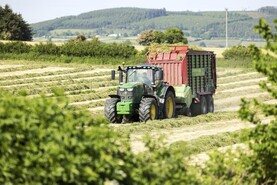Shane Keaveney farms with his wife, Gráinne, and three children just outside the town of Ballinlough in Co Roscommon.
Shane is a full-time farmer calving 36 suckler cows in spring. So running a profitable enterprise that will contribute to the overall family income is a key motivating factor for Shane.
Shane wants to be more profitable while at the same time reducing the overall carbon footprint of the farm.
There are “win-win” solutions that can be adopted on a typical suckler farm in the west of Ireland.
These include using protected urea, LESS slurry spreading and calving at two years of age.
With Shane ticking those boxes, he opted to sow a crop of red clover as a silage crop on a trial basis to help reduce his reliance on chemical N. Nothing ventured nothing gained.
It is a high-yielding crop without having to apply expensive nitrogen – good for the pocket and the environment.Higher intakes by cattle can increase animal performance and reduce Shane’s meal bill. Red clover, when ensiled correctly, can be high in crude protein.On a fragmented farm like Shane’s, some isolated land plots can be dedicated to red clover silage only getting three to four cuts per year with no need to graze it.Preparation is key. Shane corrected the phosphorus (P) and potassium (K) index, applied lime at 2t/acre and sprayed for weeds and docks prior to cultivation.
However, due to a wet April it was difficult to get the crop sown but eventually he got a window in the last few days of the month.
The crop was then hit with a very dry June and that slowed growth. The first cut was taken on 15 July and yielded eight bales/acre.
Red clover needs to be cut in dry weather and needs a 36- to 48-hour wilt. Shane applied good-quality slurry after each cut and managed to take three cuts of the red clover silage in 2023.
In summary, 2ha yielded 66 bales (27 bales/ac) which will feed the yearlings. Shane expects the yields to be better in year two. A silage sample was taken from the first cut and highlighted a high-quality silage. The only concern is the low dry matter.
Shane would like the silage to be drier. The weather was an issue in July and the crop got some rain before baling.
Shane Keaveney farms with his wife, Gráinne, and three children just outside the town of Ballinlough in Co Roscommon.
Shane is a full-time farmer calving 36 suckler cows in spring. So running a profitable enterprise that will contribute to the overall family income is a key motivating factor for Shane.
Shane wants to be more profitable while at the same time reducing the overall carbon footprint of the farm.
There are “win-win” solutions that can be adopted on a typical suckler farm in the west of Ireland.
These include using protected urea, LESS slurry spreading and calving at two years of age.
With Shane ticking those boxes, he opted to sow a crop of red clover as a silage crop on a trial basis to help reduce his reliance on chemical N. Nothing ventured nothing gained.
It is a high-yielding crop without having to apply expensive nitrogen – good for the pocket and the environment.Higher intakes by cattle can increase animal performance and reduce Shane’s meal bill. Red clover, when ensiled correctly, can be high in crude protein.On a fragmented farm like Shane’s, some isolated land plots can be dedicated to red clover silage only getting three to four cuts per year with no need to graze it.Preparation is key. Shane corrected the phosphorus (P) and potassium (K) index, applied lime at 2t/acre and sprayed for weeds and docks prior to cultivation.
However, due to a wet April it was difficult to get the crop sown but eventually he got a window in the last few days of the month.
The crop was then hit with a very dry June and that slowed growth. The first cut was taken on 15 July and yielded eight bales/acre.
Red clover needs to be cut in dry weather and needs a 36- to 48-hour wilt. Shane applied good-quality slurry after each cut and managed to take three cuts of the red clover silage in 2023.
In summary, 2ha yielded 66 bales (27 bales/ac) which will feed the yearlings. Shane expects the yields to be better in year two. A silage sample was taken from the first cut and highlighted a high-quality silage. The only concern is the low dry matter.
Shane would like the silage to be drier. The weather was an issue in July and the crop got some rain before baling.






 This is a subscriber-only article
This is a subscriber-only article










SHARING OPTIONS: